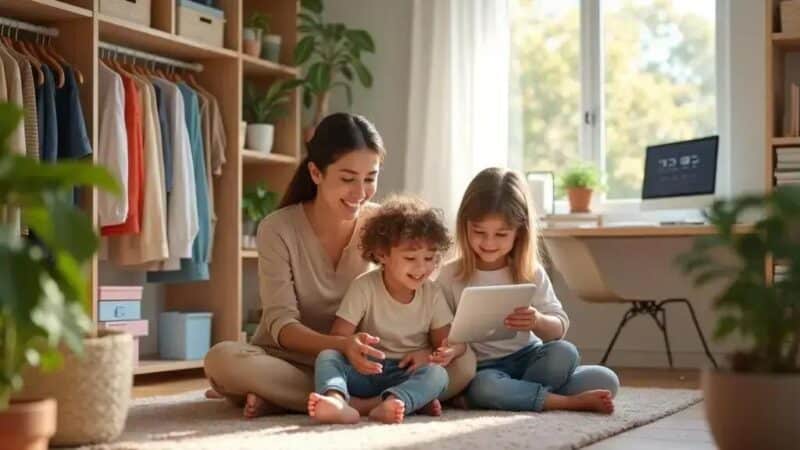ADHD women often grow up masking—so what changes when you become a parent? This story follows a public figure who turned her diagnosis into a teaching moment, pairing motherhood with inclusive design and expert-backed tips to make home and workspaces that help different minds shine. Could your environment be hiding or helping your spark?
A personal journey: motherhood, masking and reclaiming ADHD
Many ADHD women spend years hiding their true selves. This is often called \”masking.\” They try hard to fit in and act like others. This can be very tiring. Often, they don’t even know they have ADHD. They just feel different or like they are struggling more than others.
Motherhood and Unmasking
Becoming a mother can change things a lot. The demands of parenting can make masking much harder. Daily tasks, routines, and managing children’s needs can highlight ADHD traits. This can be a moment of realization for many women. They might start to wonder why things feel so difficult or overwhelming.
For some, a diagnosis comes later in life, often after having children. This can be a huge relief. It helps them understand past struggles. It also offers a new way to see themselves. They can start to embrace their neurodiversity, seeing it as a part of who they are.
Reclaiming Your Identity with ADHD
Reclaiming ADHD means accepting who you are. It’s about understanding your brain works differently. It’s not a flaw. It’s a unique way of thinking. This journey involves learning new tools and strategies. It also means being open about your diagnosis. Sharing your story can help others too. It builds a community of support. This helps reduce the stigma around ADHD and fosters self-acceptance.
Designing spaces that support neurodiverse minds: practical tips from Inclusive by Design
Creating a home or work space that truly supports everyone is key. This is called **inclusive design**. It means thinking about how different brains work. For people with ADHD, a well-designed space can make a big difference. It helps them focus, stay organized, and feel calm. Clutter and too much noise can be very distracting. A thoughtful design can reduce these problems.
Clear Spaces for Clear Minds
One simple tip is to keep things tidy. Less clutter means less visual noise. This helps the brain focus better. Think about having a place for everything. Use clear bins or labels so you know where things go. This makes it easier to put things away and find them later. An organized space helps reduce stress for **ADHD women** and their families.
Sensory Comfort and Focus Zones
Consider how your space feels. Bright, harsh lights can be overwhelming. Try softer lighting or natural light. Loud noises can also be distracting. Use rugs or curtains to help absorb sound. Create different zones in your home. Have a quiet spot for reading or focusing. Maybe a more active area for play. This helps everyone know what to expect in each part of the house.
Visual Aids and Flexibility
Visual aids can be very helpful. A calendar on the wall or a checklist can guide daily tasks. Use colors to organize items, like different colored folders for school subjects. Remember, every person is unique. What works for one might not work for another. Be flexible and ready to change things. The goal is to create a space that feels good and works well for everyone living there.
Why openness matters: research, stigma and resources for women with ADHD
Being open about having ADHD can make a big difference. When **ADHD women** share their stories, it helps everyone. It shows others they are not alone. This openness also helps reduce the negative feelings or ideas people have about ADHD. It’s important to talk about it so more people understand.
Understanding ADHD Through Research
New research helps us learn more about ADHD, especially in women. For a long time, ADHD was mostly studied in boys. Now, we know it can show up differently in girls and women. This research helps doctors give better diagnoses. It also helps create better support plans. Knowing more helps us all understand how ADHD affects daily life.
Fighting Stigma and Finding Support
Many women with ADHD face unfair judgments. This is called stigma. People might think they are just lazy or unorganized. But ADHD is a real brain difference. Being open helps challenge these wrong ideas. It creates a space where women feel safe to be themselves. There are many groups and websites that offer help. These resources provide tools, advice, and a community. They can help women with ADHD thrive and feel supported.
Where to Find Help
If you or someone you know needs support, there are places to turn. Look for local ADHD support groups. Many online communities also offer a safe space to share and learn. Websites like CHADD or ADDA have lots of information. They can connect you with experts and other women who understand. Remember, you don’t have to go through this alone.
Fonte: Fortune.com








